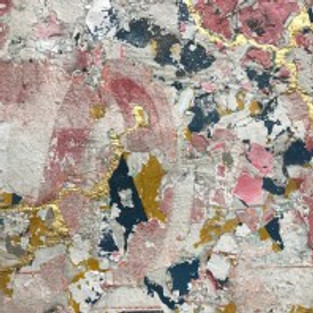Alfredo Romero at Simard Bilodeau
- artandcakela
- May 27, 2019
- 3 min read
Updated: Jan 27

Alfredo Romero, Vestiges of Our Times, Simard Bilodeau Contemporary; Photo credit Genie Davis
Scarred, Worn, Ghostly, Gorgeous: Vestiges of Our Times
Simard Bilodeau Contemporary, Los Angeles through May 29
Written by Genie Davis
Vestiges of Our Times, now at Simard Bilodeau Contemporary, is a vision of Mexico’s past and a poignant look at the present. Artist Alfredo Romero uses the technique of strappo to detach paintings and murals from the walls of deteriorating structures, and in so doing, gives these images a new life.
While Romero is capturing startlingly delicate, seemingly ghostly colors and shapes of Mexico’s past, he is using a Japanese aesthetic, and often a Japanese art technique as well. In terms of the aesthetic, Romero is embracing the idea of wabi-sabi, or the acceptance of both transience and the imperfect. The technique he uses in a number of the beautifully worn images he creates is that of kintsugi, a traditional Japanese art that uses liquid gold, silver, or lacquer mixed with powdered gold to join the fragments of a broken ceramic item and enhance, or even revere, the breaks.
In Romero’s work, he uses the latter technique to highlight, accentuate, and celebrate the cracks or fissures in the image that he creates.
The images themselves are that of beautifully hand-created commercial advertisements, steeped in nostalgia, they are graceful, and pale with age. There are Coca-Cola logos, a floating yellow sea horse, a blue Nestle sign, an advertisement for tortas and tacos, and others that are less discernable in meaning, such as the mosaic-like creation of a work titled “Pink Love Street.”
Some images are crumbling, some browned and eroded, some reveal multiple layers of images and words. They are like worn, tattooed skin, richly tangible, historic, and transformed from what was once the skillful but mundane, into a richer expression.
The exhibition touches on many things: an elegiac ode to the passage of time; the human ability to render some relics obsolete and forgotten while others are treasured; the legacy of age; our simultaneous fascination with the past and our disregard of it.
Taking the images from the actual walls on which they were created, Romero and a team lift these iconic advertisements from the architectural structures on which they originally were created, and places them on cotton canvas. The process is careful and painstaking. Once placed, he adds his own markings, reshaping the works subtly, altering their DNA in such a way as to refine it, creating abstract images that serve as both a tribute to commercial culture and an elevation of it.
He will add a painted mark or shape or an application of gold leaf between broken images. At times, with the most worn pieces, he seems to be shaping a kind of artistic map from the broken image, as if he had placed sparkling rivers within the mysterious lines and patterns of a faded geologic map.
The result is something dreamlike, fanciful; work that goes beyond the history it preserves. He also goes within it. The Spanish-born artist, now based in Mexico, finds and interviews business owners whose signs these once were, learning about and documenting their literal history.
But what makes these works so special is not their literal interpretation, but the honestly mesmerizing artistic abstraction of what were once commercial images — to portray who we once were, and who we are now. If Romero’s art is a vestige of the past, so are we. What precious, transitory, altered schemata do we bear, and how has time weathered us, and lined us with gold?
Simard Bilodeau Contemporary 1923 S. Santa Fe Ave., Los Angeles
#losangeles #california #losangelesartist #art #painting #shoeboxpr #geniedavis #laverne #losangelesart #contemporaryart #southerncalifornia #abstract #collage #AlfredoRomero #artgallery #artinterview #gallery #museum #artandcake #artexhibition #installation #fineart #artist #soloshow #mixedmedia #arts #artreview #artmagazine #ArtandCulture #SimardBilodeauContemporary #exhibition #exhibit


































